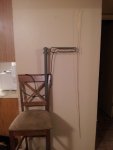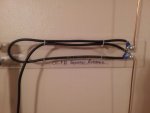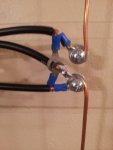KC4RAF
Member
On your 1/2 copper pipe,
is it "L" or "M"?
"L" is heavier and tighter fit to connectors. And cost a couple of dollars more.
When I bought pipe at Lowes, they had "L" and "M" in the same rack, and I didn't check until I got home and saw the price difference, (IIRC it was about 3 bucks more for the L).
The fit was very tight and I used sandpaper to get it ready for soldering and then the flux acted like grease to fit it together.
edit: My bad. I see where you are using PVC fittings etc. Disregard my useless post.
is it "L" or "M"?
"L" is heavier and tighter fit to connectors. And cost a couple of dollars more.
When I bought pipe at Lowes, they had "L" and "M" in the same rack, and I didn't check until I got home and saw the price difference, (IIRC it was about 3 bucks more for the L).
The fit was very tight and I used sandpaper to get it ready for soldering and then the flux acted like grease to fit it together.
edit: My bad. I see where you are using PVC fittings etc. Disregard my useless post.
Last edited:




